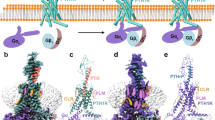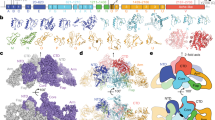Abstract
Corticosteroid binding globulin (CBG) and thyroxin binding globulin (TBG) both belong to the same SERPIN superfamily of serine–proteinase inhibitors but in the course of evolution CBG has adapted to its new role as a transport agent of insoluble hormones. CBG binds corticosteroids in plasma, delivering them to sites of inflammation to modify the inflammatory response. CBG is an effective drug carrier for genetic manipulation, and hence there is immense biological interest in the location of the hormone binding site. The crystal structure of human CBG (hCBG) has not been determined, but sequence alignment with other SERPINs suggests that it conforms as a whole to the tertiary structure shared by the superfamily. Human CBG shares 52.15% and 55.50% sequence similarity with α1-antitrypsin and α1-antichymotrypsin, respectively. Multiple sequence alignment among the three sequences shows 73 conserved regions. The molecular structures of α1-antitrypsin and α1-antichymotrypsin, the archetype of the SERPIN superfamily, obtained by X-ray diffraction methods are used to develop a homology model of hCBG. Energy minimization was applied to the model to refine the structure further. The homology model of hCBG contains 371 residues (His13 to Val383 ). The secondary structure comprises 11 helices, 15 turns and 11 sheets. The putative corticosteroid binding region is found to exist in a pocket between β-sheets S4, S10, S11 and α helix H10. Both cortisol and aldosterone are docked to the elongated hydrophobic ligand binding pocket with the polar residues at the two extremities. A difference accessible surface area (DASA) study revealed that cortisol binds with the native hCBG more tightly than aldosterone. Cleavage at the Val379–Met380 peptide bond causes a deformation of hCBG (also revealed through a DASA study). This deformation could probably trigger the release of the bound hormone.
Figure Stereoscopic view of the ribbon diagram of hCBG complexed with cortisol. The bound cortisol is shown in space filling model in blue. Helices and sheets are shown in red and magenta respectively. Turns are shown in yellow.







Similar content being viewed by others
References
Hammond GL, Smith CL, Underhill DA (1991) J Steroid Biochem Mol Biol 40:755–762
Strel'chyonok OA, Avvakumov GV (1991) J Steroid Biochem Mol Biol 40:795–803
Hammond GL, Smith CL, Paterson NA, Sibbald WJ (1990) J Clin Endocrinol Metabol 71:34-39
Seralini GE (1991) CR Seances Soc Biol Fil 185:500–509
Hammond GL, Smith CL, Underhill CM, Nguyen VT (1990) Biochem Biophys Res Commun 1172:172–177
Pemberton PA, Stein PE, Pepys MB, Potter JM, Carrell RW (1988) Nature 336:257–258
Edger P, Stein P (1995) Structural Biol 2:196–197
Ryu SE, Choi HJ, Kwon KS, Lee KN, Yu MH (1996) Structure 4:1181–1192
Lukacs CM, Rubin H, Christianson DW (1998) Biochemistry 37:3297–3304
Lee B, Richards FM (1971) J Mol Biol 55:379–400
Hammond GL, Smith CL, Goping IS, Underhill DA, Harley MJ, Reventos J, Musto NA, Gunsalus GL, Bardin CW (1987) Proc Natl Acad Sci USA 84:5153–5157
Kato EA, Hsu BR, Kuhn RW (1988) J Steroid Biochem 29:213–220
Bardin CW, Gunsalus GL, Musto NA, Cheng CY, Reventos J, Smith C, Underhill DA, Hammond G (1988) J Steroid Biochem 30:131–139
Grenot C, Blachere T, Rolland de Ravel M, Mappus E, Cuilleron CY (1994) Biochemistry 33:8969–8981
Needleman SB, Wunsch CD (1970) J Mol Biol 48:443–453
Feng DF, Doolittle RF (1987) J Mol Evol 25:351–360
Biosym Technologies (1995) Inc Insight II and Discover Reference. Gu 10065 Barnes Canyon Rd, San Diego, CA 92121, USA
Kabsch W, Sander C (1983) Biopolymers 22:2577–2637
Hagler AT (1985) In: Hurby VJ, Meienhofer J (eds) The peptides. Academic Press, New York, pp 213–299
Dauber-Osguthorpe P, Roberts VA, Osguthorpe DJ, Wolff J, Genest M, Hagler AT (1988) Proteins Struct Funct Genet 4:31–47
Roberts RJ, Coppola JC, Isaacs NW, Kennard O (1973) J Chem Soc, Perkin Trans 2:774–781
Jones G, Willett P, Glen RC (1995) J Mol Biol 245:43–53
Jones G, Willett P, Glen RC, Leach AR, Taylor R (1997) J Mol Biol 267:727–748
Travis J, Salvesen GS (1983) Annu Rev Biochem 52:655–709
Huber R, Carrell RW (1989) Biochemistry 28:8951–8966
Terry CJ, Blake CCF (1992) Protein Eng 5:505–510
Jarvis JA, Munro SLA, Craik DJ (1992) Protein Eng 5:61–67
Yamashita S, Suzuki A, Yanagita T, Hirohata S, Toyoshima S (2001) Biol Pharm Bull 24:119–122
Laskowski R, Mac Arthur M, Moss D, Thornton J (1993) J Appl Crystallogr 26:91–97
Defaye G, Basset M, Monnier N, Chambaz EM (1980) Biochim Biophys Acta 623:280–294
Mickelson KE, Forsthoefel J, Westphal U (1981) Biochemistry 20:6211–6218
Avvakumov GV, Warmels-Rodenhiser S, Hammond GL (1993) J Biol Chem 268:862–866
Avvakumov GV, Hammond GL (1994) J Steroid Biochem Mol Biol 49:191–194
Avvakumov GV (1995) J Steroid Biochem Mol Biol 53:515–522
Acknowledgement
Thanks are due to D.I.C., Bose Institute, Calcutta for providing the computational facilities for the modeling work.
Author information
Authors and Affiliations
Corresponding author
Rights and permissions
About this article
Cite this article
Dey, R., Roychowdhury, P. Homology model of human corticosteroid binding globulin: a study of its steroid binding ability and a plausible mechanism of steroid hormone release at the site of inflammation. J Mol Model 9, 183–189 (2003). https://doi.org/10.1007/s00894-003-0130-4
Received:
Accepted:
Published:
Issue Date:
DOI: https://doi.org/10.1007/s00894-003-0130-4




